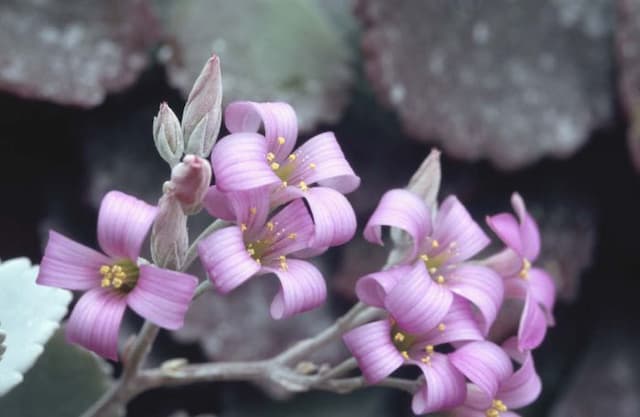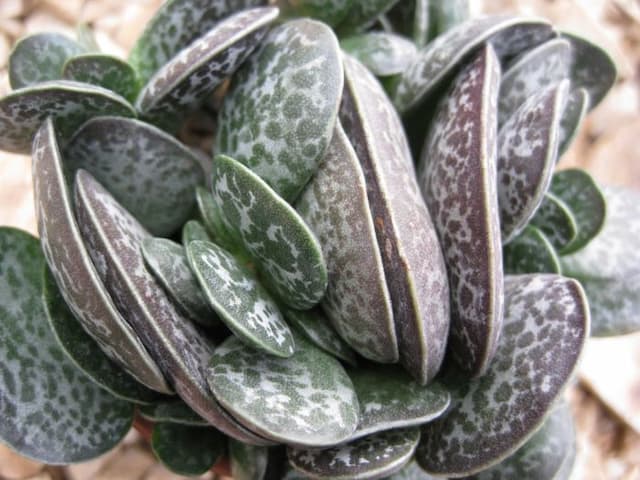Kalanchoe Millotii Kalanchoe millotii

ABOUT
Kalanchoe millotii is a succulent plant well-known for its striking foliage. The leaves of this plant adopt a distinctive textural appearance, being covered with fine, velvety hairs that give them a soft, fuzzy feel and a matte finish. The leaves are generally arranged in rosettes and are a rich green color, often with serrated edges that add to their visual interest. This unique texture not only adds to the tactile aesthetics but also helps the plant in water conservation. The fleshy leaves are thick and sturdy, typical of succulents, capable of storing water to endure drier conditions. Throughout the year, these plants show little change in color, maintaining their lush appearance. When it flowers, it produces small, inconspicuous flowers that are typically yellow-green. These blooms may not be as flashy as those on other ornamentals, but they offer a subtle charm that can complement the plush foliage. This plant has a compact growth habit, which makes it suitable for keeping in smaller spaces where it can bring a touch of greenery without overpowering the area. It's a popular choice for indoor plant enthusiasts, as well as for outdoor rockeries or succulent gardens where the climate is appropriate. The overall effect of Kalanchoe millotii's distinctive leaves and modest blooms is of a plant that is both understated and sophisticated, ideal for enhancing a space with a natural yet curated vibe.
About this plant
 Names
NamesFamily
Crassulaceae
Synonyms
Millot Kalanchoe, Felt Bush
Common names
Kalanchoe millotii
 Toxicity
ToxicityTo humans
Kalanchoe millotii, commonly known as felt bush, is not typically considered highly toxic to humans. However, as with many plants in the Kalanchoe genus, it contains compounds that can be mildly irritating if ingested or if the sap comes into contact with the skin. In some people, consuming parts of the plant might lead to gastrointestinal discomfort such as nausea, vomiting, or diarrhea. It is always advisable for humans to avoid ingesting plants that are not generally recognized as food, as individual reactions can vary.
To pets
Kalanchoe millotii, commonly known as felt bush, is toxic to pets, including cats and dogs. It contains cardiac glycosides that can be harmful if ingested. Symptoms of poisoning in animals may include vomiting, diarrhea, drooling, and changes in heart rate. In severe cases, ingestion can lead to abnormal heart rhythms, tremors, or seizures. It is important to keep this plant out of reach of pets to prevent accidental ingestion, and seek veterinary care if you suspect your pet has eaten any part of the plant.
 Characteristics
CharacteristicsLife cycle
Perennials
Foliage type
Evergreen
Color of leaves
Green
Height
1 feet (30 cm)
Spread
1 feet (30 cm)
Plant type
Succulents
Hardiness zones
10
Native area
Madagascar
Benefits
 General Benefits
General Benefits- Easy to Care - Kalanchoe millotii is a low-maintenance plant that thrives with minimal care, making it ideal for busy plant lovers or beginners.
- Drought Tolerant - It is highly drought-resistant, requiring infrequent watering, which conserves water resources.
- Aesthetic Appeal - With its interesting foliage and structure, it adds visual interest and a touch of nature to indoor and outdoor spaces.
- Succulent Characteristics - As a succulent, it stores water in its leaves, which can be beneficial in xeriscaping and water conservation gardening practices.
- Propagation Ease - The plant is easily propagated through leaf cuttings, allowing gardeners to create more plants without additional cost.
- Long Blooming Period - When it blooms, the flowers can last for a considerable amount of time, providing a longer period of visual enjoyment.
- Non-Toxic to Pets - Kalanchoe millotii is not toxic, which makes it a safe choice for households with pets.
- Versatile Placement - It can be placed in a variety of locations, from hanging baskets to desktop planters, complementing different decor styles.
 Medical Properties
Medical PropertiesThis plant is not used for medical purposes.
 Air-purifying Qualities
Air-purifying QualitiesThis plant is not specifically known for air purifying qualities.
 Other Uses
Other Uses- Kalanchoe millotii can be used as a unique addition to mixed succulent arrangements, providing textural contrast with its characteristically fuzzy leaves.
- This plant can be a thoughtful gift for plant enthusiasts who appreciate rare or unusual succulents in their collection.
- As a terrarium plant, Kalanchoe millotii's small size and low maintenance make it ideal for creating miniature landscapes within glass containers.
- In art, it can inspire botanical illustrations or be a living subject for photography projects due to its unique appearance.
- It serves as an educational tool in botany classes to demonstrate plant adaptation, such as its thick leaves that help retain water in arid conditions.
- Kalanchoe millotii can be incorporated in rock gardens, complementing stones with its fleshy leaves and contributing to an alpine-like environment.
- Can be utilized in xeriscaping, a landscaping method that reduces or eliminates the need for supplemental water from irrigation.
- It can be used as a natural ornament during festive seasons, often potted in decorative containers to match the theme like Christmas or Easter.
- Due to its slow growth and ease of care, Kalanchoe millotii is suitable for use in offices or as desk plants, adding a touch of greenery with minimal maintenance.
- This plant can act as a living mulch in larger pots, covering the soil and helping to retain soil moisture for companion plants.
Interesting Facts
 Feng Shui
Feng ShuiThe Kalanchoe is not used in Feng Shui practice.
 Zodiac Sign Compitability
Zodiac Sign CompitabilityThe Kalanchoe is not used in astrology practice.
 Plant Symbolism
Plant Symbolism- Resilience: Kalanchoe millotii is known for its hardy nature, symbolizing the ability to withstand challenging conditions and thrive in adversity.
- Healing: Many species of Kalanchoe have medicinal properties, leading them to symbolize physical and emotional healing.
- Endurance: This plant has a remarkable capacity for water storage, representing the ability to endure and sustain itself even in tough times.
- Persistence: Kalanchoe millotii can regenerate from a single leaf, symbolizing persistence and the drive to grow despite obstacles.
- Longevity: With its ability to live for many years and keep blossoming, this plant represents longevity and ongoing vitality.
 Water
WaterKalanchoe millotii, commonly known as Velvet-Leaf Kalanchoe, requires moderate watering, often about once a week. The specific frequency of watering can vary depending on the humidity and temperature of its environment; it is crucial to allow the soil to completely dry out between waterings. When the top inch of the soil feels dry, water the plant thoroughly until excess water drains out of the bottom of the pot, which should be roughly every 7 to 10 days. It is better to err on the side of underwatering, as overwatering can lead to root rot. An average watering might involve approximately 8 to 16 ounces of water for a small to medium-sized plant, depending on pot size and environmental conditions.
 Light
LightVelvet-Leaf Kalanchoe thrives best in bright, indirect light. A spot near a window that gets filtered sunlight is ideal, as direct sunlight can cause leaf burn. If you place it indoors, an east or west-facing window would provide the optimal lighting conditions. However, it can also adapt to lower light areas but may become leggy as it stretches toward the light source.
 Temperature
TemperatureVelvet-Leaf Kalanchoe prefers warm temperatures and does not tolerate frost. It can survive minimum temperatures around 40 degrees Fahrenheit and maximum temperatures as high as 100 degrees Fahrenheit, but the ideal temperature range is between 60 and 85 degrees Fahrenheit. Always protect the plant from extreme temperatures to prevent damage.
 Pruning
PruningPruning Velvet-Leaf Kalanchoe is essential for maintaining its attractive shape and encouraging bushier growth. It should be pruned after it finishes blooming, which can occur at various times depending on the growing conditions. Cut back the flower stalks and any leggy growth. You can prune the plant once or twice a year to keep it compact and remove dead or wilted leaves and blooms to promote healthier growth.
 Cleaning
CleaningAs needed
 Soil
SoilKalanchoe tomentosa, commonly known as Panda Plant, thrives in well-draining soil mix suited for cacti and succulents, with a pH between 6.0 and 7.5. A mix of 60% peat moss or coco coir and 40% perlite or sand is ideal, ensuring good aeration and drainage while retaining some moisture.
 Repotting
RepottingPanda Plant should be repotted every two to three years to refresh the soil and provide room for growth. The repotting is best done in the spring or early summer when the plant is actively growing.
 Humidity & Misting
Humidity & MistingPanda Plant prefers average to low humidity conditions and can tolerate dry indoor environments well. They thrive in humidity levels between 40% and 60%, but can adapt to levels outside this range provided they are not too extreme.
 Suitable locations
Suitable locationsIndoor
Place in bright, indirect light and water sparingly.
Outdoor
Shelter from harsh sun; water when soil dries.
Hardiness zone
9-11 USDA
 Life cycle
Life cycleKalanchoe millotii, commonly known as Millot Kalanchoe, begins its life as a seed, typically germinating in warm, moist soil in a process that can take several weeks. After germination, seedlings emerge and develop into juvenile plants, forming a basal rosette of scalloped, fuzzy green leaves. As it matures, the plant undergoes vegetative growth, expanding its rosette and possibly producing offsets or "pups" that can grow into new individual plants. Upon reaching maturity, Millot Kalanchoe produces clusters of small, greenish flowers, usually in the cooler months, signaling its reproductive phase. After pollination, which is usually facilitated by insects, fruits develop and eventually release seeds, completing the life cycle. Throughout its life, Millot Kalanchoe experiences periods of growth and dormancy, typically coinciding with seasonal changes in temperature and light.
 Propogation
PropogationPropogation time
Spring-Summer
Kalanchoe millotii, commonly known as velvet leaf kalanchoe, can be easily propagated through leaf cuttings, which is the most popular method for this plant. To propagate, select a healthy, full-grown leaf and gently twist it from the stem, ensuring a clean separation. Allow the leaf to callus over for a day or two to prevent rotting when planted. After the callusing, place the leaf on top of a well-draining soil mix, slightly pressing it into the surface. Keep the soil moderately moist but not waterlogged and ensure a warm environment with indirect sunlight. Roots will typically emerge within 2 to 3 weeks, followed by the development of tiny plants at the base of the cutting. Once these new plants have grown sufficiently, they can be transplanted into their own pots to continue growing into mature kalanchoe plants.









